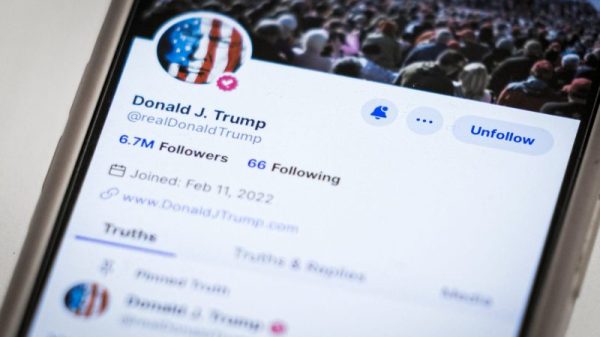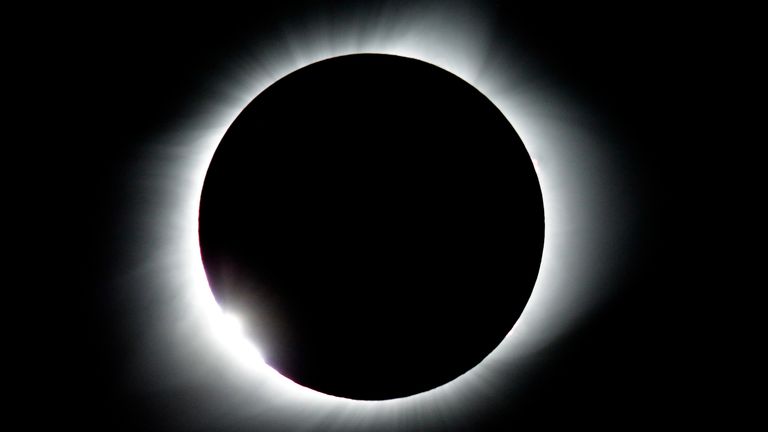A total solar eclipse will dazzle people on Monday in what’s been described as “our planet’s greatest spectacle”.
The perfect alignment of Earth, the sun and the moon will be seen on 8 April – meaning people in North America will experience a total solar eclipse, which will plunge much of the continent into darkness.
But people in parts of the UK will be able to see a partial eclipse too.
So where can you see it, why is this one so special and is there anything you need to be aware of? Here’s everything to know.
In the UK
Although North America will enjoy the full spectacle of a total eclipse, people in parts of the UK will get to see a partial eclipse.
Dr Edward Bloomer, senior astronomer at the Royal Observatory Greenwich, said the UK is only going to get “a small grazing” of the eclipse in the West and North of the country.
The start of the partial eclipse will be at 7.52pm (BST) and it will end by 8.51pm.
Here’s where you might see it – weather permitting:
In Glasgow, about 12% of the sun will be obscured at around 8pm (BST).
Edinburgh could see a 6% obscuration.
Liverpool will only see a maximum of 3.1% coverage at 7.57pm when the sun is right on the horizon – the window is very small as the start and end times are 7.55pm and 8pm.
Belfast will be treated to more of an eclipse with a maximum of 28.1% coverage at 8.10pm – the full window in which people might see it here is 7.55pm until 8.14pm.
Stornoway in Scotland will see 33.7% maximum coverage at 8.13pm. Here it will start at 7.53pm and end at 8.23pm.
Anything in London?
Sadly, no.
Dr Bloomer said: “I’m afraid the South and the East are out of luck this time around.
“We won’t ourselves get to see anything from the observatory, which we’re a bit sad about.”
However, you can watch our live coverage of the total eclipse on the Sky News channel, the Sky News app or on our YouTube channel.
NASA will also be providing a live stream of the celestial event, providing telescope views from several sites along the eclipse path.
You’ll be able to watch that on NASA’s official YouTube channel or on its site here.
In Ireland
As well as Belfast and Derry in Northern Ireland, people in the Republic of Ireland will have a chance to see the partial eclipse.
The best opportunities will be in the West. The town of Belmullet, in County Mayo on Ireland’s west coast, could be treated to an eclipse which covers 44% of the sun, according to UK Weather Updates on X.
The account also says Galway will be a good spot to catch the partial eclipse, where it’s estimated more than 35% of the sun will be covered.
It will also be possible to watch in Ireland’s capital, Dublin. But here it’s thought only around 15% of the sun will be covered.
In the US, Mexico and Canada
The US, Mexico and Canada will be in the totality path of the eclipse, meaning more than 31 million people across 15 states will be treated to the mesmerising sight of the sun being obscured by the moon.
The time it will last in each area varies from just under four-and-a-half minutes in Zaragoza in Mexico to around a minute in Montreal, Canada.
According to NASA, the first location in North America where people will be able to view the eclipse in totality will be Mexico’s Pacific coast at around 11.07am PDT.
The eclipse’s path will then enter the United States in Texas and travel through Oklahoma, Arkansas, Missouri, Illinois, Kentucky, Indiana, Ohio, Pennsylvania, New York, Vermont, New Hampshire, and Maine.
Small parts of Tennessee and Michigan will also experience the total eclipse, before the path moves on to Canada in Southern Ontario, Quebec, New Brunswick, Prince Edward Island, and Cape Breto. Its last sighting will be in Newfoundland.
What exactly do people see during a full solar eclipse?
The event will see the sky fall dark as if it were dawn or dusk, and a halo form around the sun as its light is blocked out by the moon.
If there is clear weather, people along the eclipse’s path will see the sun’s corona, or outer atmosphere, which is usually obscured by the bright face of the sun, according to NASA.
NASA urges viewers to wear specialised eye protection during the eclipse, as it’s not safe to look at the sun apart from at the very brief moment when it’s completely blocked by the moon.
“A total solar eclipse is one of the grandest sights in nature – and may be very rare anywhere in the galaxy,” Chris Lintott, professor of astrophysics at the University of Oxford, told Sky News.
“I get a shiver down my spine every time,” he added.
Partial solar eclipses are known to make the sun appear to have had a bite taken out of it, because the moon only covers part of the sun rather than the entire thing.
Why is this one so special?
This one’s a bit of an anomaly because total solar eclipses are only meant to happen once every 375 years in any one place in the world – yet people in the US state of Illinois will see it for the second time in seven years.
The 21,000-strong city of Carbondale in Illinois saw a total solar eclipse in August 2017 and the fact people there will now see one again so soon afterwards is incredibly rare.
It’s earned the state a new nickname – the ‘eclipse crossroads of America’.
“Southern Illinois is considered the eclipse crossroads of America because it was in the centreline for the path of totality in 2017 and will be again in 2024,” the Illinois Department of Natural Resources said.
Why scientists are excited too
Both professional and amateur scientists plan to carry out experiments and observations as Earth falls dark.
NASA’s deputy chief Pam Melroy says it will give an “entirely different” opportunity to study the interaction between the Earth, moon and sun.
The US space agency and others will focus much of their work on observing the corona, the sun’s outer atmosphere, which can’t normally be seen because the sun is too bright.
During an eclipse, though, the corona’s white halo can be seen bursting out from behind the shadow. It’s hundreds of times hotter than the sun’s surface and it’s the source of solar wind.
It’s also a complete enigma. Scientists still don’t know how the corona is heated to such extreme temperatures.
NASA’s scientists will be hoping to get more data on it, as well as answers to other questions when they send research planes as high as 50,000ft (9.5 miles) to conduct a series of experiments on 8 April.
Some of the things they’re hoping to observe include:
- How fast particles are moving when they are flung out into space
- Photographing in both infrared and visible light to try to identify new details in the middle and lower corona
- Using a spectrometer to study light from the corona, hopefully learning more about the temperature and chemical composition of the corona and the particles it emits
- Studying a dust ring around the sun. Dust is the leftover remnants from when the solar system was forming
- Searching for asteroids orbiting nearby.
Hundreds of citizen scientists are also expected to get involved in Monday’s eclipse, looking at things like the quietening of birds and other wildlife, the dip in temperature as the sun is blocked, and what effect there is on communications.
US university students will be releasing hundreds of weather balloons to monitor atmospheric changes.
Are there any health warnings?
Yes. You could permanently damage your eyes if you try to watch the eclipse with normal sunglasses.
If you are planning on looking directly at it, you need proper eclipse glasses, which are “thousands of times darker” than sunglasses, according to NASA.
But you need to make sure they work, as bogus retailers capitalise when an eclipse is due and you may be duped into buying a counterfeit pair.
The American Astronomical Society advises these three steps to check if your glasses are safe.
1. “Put them on indoors and look around. You shouldn’t be able to see anything through them, except perhaps very bright lights, which should appear very faint through the glasses. If you can see anything else, such as household furnishings or pictures on the wall, your glasses aren’t dark enough for solar viewing.”
2. “If your glasses pass the indoor test, take them outside on a sunny day, put them on, and look around again. You still shouldn’t see anything through them, except perhaps the Sun’s reflection off a shiny surface or a puddle, which again should appear very faint.”
3. “If your glasses pass that test too, glance at the Sun through them for less than a second. You should see a sharp-edged, round disk (the Sun’s visible “face”) that’s comfortably bright. Depending on the type of filter in the glasses, the Sun may appear white, bluish-white, yellow, or orange.”
If you feel your glasses pass all these tests, they are “probably safe”, says the AAS.
When will a full solar eclipse next be seen in the UK?
A partial eclipse will be viewed across 90% of the country in 2026, but it won’t be a total one until 2081 in the Channel Islands or 2090 in the South West.
The last full solar eclipse seen in the UK came in 1999, which was spotted over Cornwall and parts of Devon. Unfortunately, clouds covered it from view in most other areas it should have been spotted over.
Total solar eclipses generally occur every 18 months or so, but whether or not you can see one depends on where you are in the world and, of course, the weather. Partial ones take place between two and five times a year – with the same caveats.



























